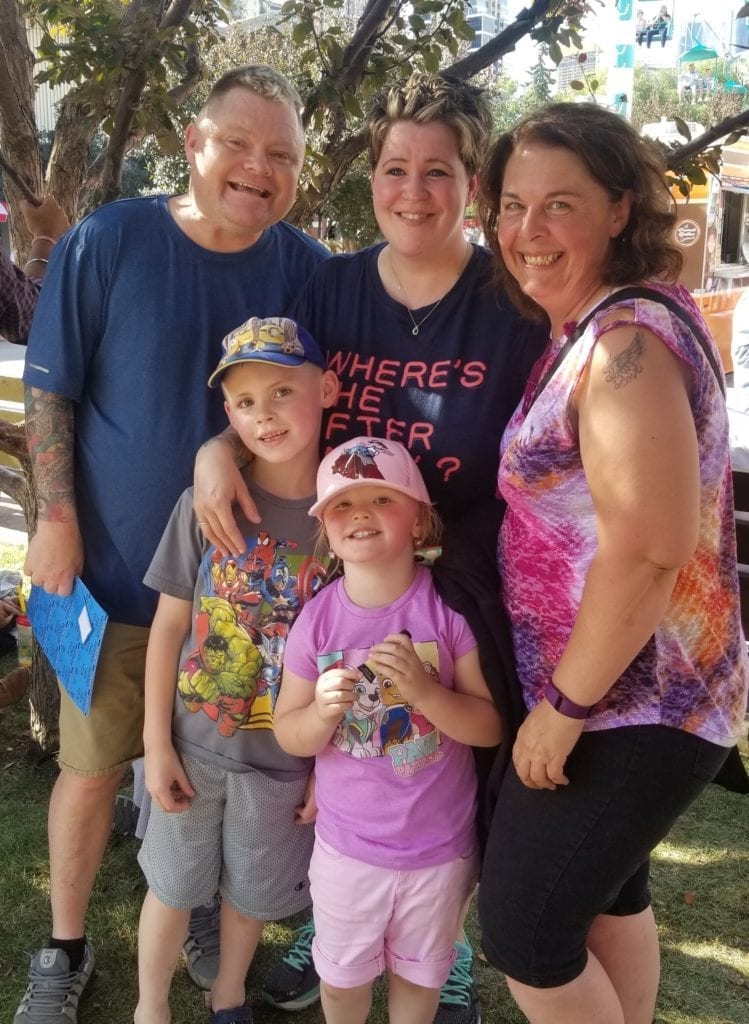Shanda McCutcheon
Calgary, Alberta, Canada
 |
| Three Months Post Donation, Michael, his wife Rebecca and their two youngest children with Shanda (far right) Source: Personal photograph of author |
Most mornings I wake and it does not seem like it happened at all. Still half asleep, I step under the cascading waters of a warm shower without even thinking about it. Life does not seem much different than it did a year ago, except that then I was embarking on the greatest journey of my life. As I lather my body with soap, my fingertips caress the finer details of the scars I will carry with me on all future adventures and journeys. I also carry with me the knowledge that I saved a life.
I do not miss my left kidney. At times I feel a twinge of pain, but it is not real. I have to remind myself that it is just phantom pain. Medically, the verdict is out on whether phantom pain even exists. I wonder sometimes. Perhaps the only reason I experience it is because other living kidney donors mentioned it. I take it as my cue to drink another glass of water.
My kidney recipient, a husband and father of three from the city I live in, did not feel the sudden burst of energy which my transplant coordinator told me many do. Still, I was able to get up soon after surgery and walk across the hallway to see him. It humored me to see how excited he was about producing so much urine. It seemed crazy to be excited about pee! It occurred to me, when I saw the bag of urine hanging off of his bed, that I had taken for granted the many nights of waking up from a dead sleep to empty my bladder.
Another thing I had not considered throughout the year of poking, prodding, and hoping to free Michael from the many hours he was connected to a dialysis machine each week, was that while my right kidney would suddenly feel like an only child in my body, my left kidney, when it was in his body, would occupy a new, unique space. It was not until Michael showed me his incision in the shape of a hockey stick that I realized he would carry his secondhand kidney like a mother kangaroo carries her newborn, in a pouch at the lower front of the belly. Michael and I agreed to refer to his newly adopted organ as Roo.
Perhaps in thirty years, I will miss my kidney. In thirty years however, I will probably still have no idea what it is like to have to contemplate the potential of dying while on a transplant waiting list. Thirty years from now, I will still have no regrets for making the choice to “share my spare,” as the term has been coined among the living kidney donor population. Just as it was almost unheard of thirty years ago for someone to undergo major surgery to give an essential organ to someone else, three decades is also a long time for medicine to progress. Even now, progress is being made towards replacing dialysis with an implantable bio-artificial kidney. I have confidence that in thirty years researchers will have the education and passion to eradicate the need for kidney donation altogether.
If I donate blood every time I am eligible in the next thirty years, I will have contributed to saving lives another one hundred and thirty-five times before I might even start to miss my left kidney. My mother would have been proud of me. It has been almost nineteen years since I promised her that I would not ignore my call to advocacy. Knowing how much she worried when I gave birth to my daughter by C-section, I know that she would not have wanted to wait outside of the operating room while I underwent an elective surgery to donate a kidney. But I also know that she would have loved Michael and his family, particularly his mother. Michael’s mother told me about the daughter she had lost to multiple sclerosis and how grateful she felt that there was still hope she would not have to face the loss of her son. “A mother never wants to live long enough to bury their child,” she told me. If my mother was alive, she would have agreed.
It seems strange, but sometimes I wonder if Michael’s wife had not posted a plea on Facebook for someone to test as a potential living donor for her husband, if our paths might still have otherwise met. Given that siblings have a fifty percent chance of being a half match as a living kidney donor, and I was a four-antigen match out of six for Michael, I am almost certain they would have. In any regard, we are now part of one another’s story.
I think I will buy a bikini to wear on the beach next summer. Maybe someone will be brave enough to ask me about the scars on my belly and I will have the courage to talk to them about their wishes regarding organ and tissue donation, and encourage them to talk about it with their families.
SHANDA McCUTCHEON: As the daughter of a multi-organ and tissue donor, Shanda is an advocate for life saving and improving donor programs as well as a living kidney donor to a member of the community whom she met through social media. Participating formally and informally in advocacy campaigns throughout almost two decades at municipal, provincial, and national levels in Canada, she subscribes to the belief that education and participation lead to wellness in the community and chooses to lead by personal example. Shanda is a Certified Grief Recovery Specialist ® and the mother of an adult daughter who works in healthcare.
Winter 2019 | Sections | Nephrology & Hypertension

Leave a Reply